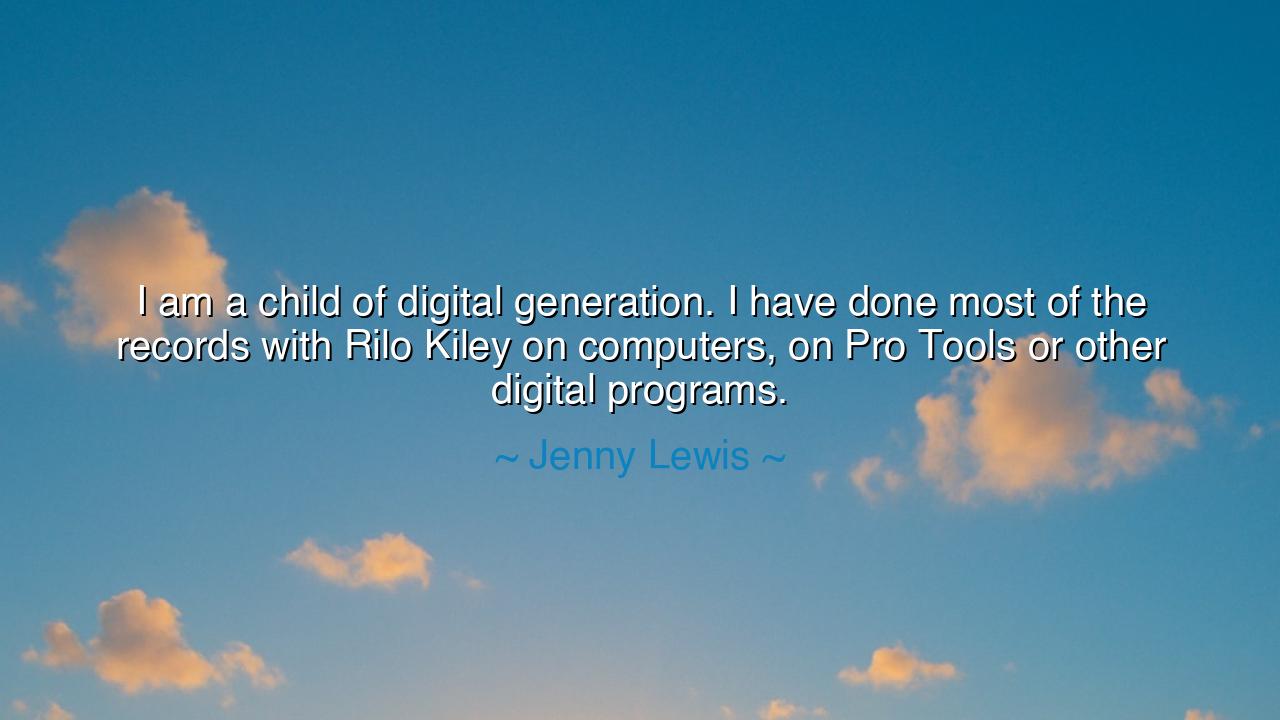
I am a child of digital generation. I have done most of the
I am a child of digital generation. I have done most of the records with Rilo Kiley on computers, on Pro Tools or other digital programs.






In the reflective and resonant words of Jenny Lewis, musician, songwriter, and voice of a generation caught between analog past and digital present, we find both a declaration of identity and a quiet meditation on change: “I am a child of the digital generation. I have done most of the records with Rilo Kiley on computers, on Pro Tools or other digital programs.” In this statement, Lewis speaks not only of her craft, but of her era — of the transformation of art itself under the touch of technology. Her words echo with the awareness that she belongs to a lineage of creators who stand at the crossroads of two worlds: one of warm imperfection and one of precise innovation.
The origin of this quote lies in Lewis’s experience as a musician rising in the early 2000s, during a time when the traditional recording studio — filled with magnetic tape, analog consoles, and the scent of electricity — began to yield to the quiet hum of the digital workstation. The band Rilo Kiley, known for its introspective lyrics and emotional depth, crafted its sound in this evolving space, where computers became both instrument and medium. The programs she names — Pro Tools and other digital technologies — were the new canvases upon which the artists of her generation painted their songs. Lewis acknowledges that she is a child of the digital age, not by accident but by nature; the tools of her art are born from circuits and code, not tape and reel.
Her words, though modest, carry the weight of a vast artistic shift — the passing of one era into another. The ancients of music — the engineers of Abbey Road, the jazz masters of Blue Note, the pioneers of vinyl and tape — built their art through touch, through the hiss of microphones and the warmth of imperfection. But for Lewis and her peers, sound was born through pixels instead of pulses, through algorithms instead of analog grooves. Yet, far from lamenting this, she embraces it — for every generation must create with the tools of its time. Just as the sculptors of marble gave way to the painters of canvas, and the quill to the printing press, so too has music’s craft evolved, reshaped by the technology that defines the human moment.
This transformation is not unique to music. It mirrors the eternal truth that art and innovation are inseparable companions. When Johannes Gutenberg built the printing press in the fifteenth century, poets and scholars feared that the sacred craft of hand-copying would die. Yet what followed was not destruction, but rebirth — a new age of expression, learning, and connectivity. So it is with the digital generation that Lewis represents. Computers have not extinguished creativity; they have multiplied its voices. Through her words, she reminds us that technology, when wielded with heart, is not the enemy of humanity but its extension. The machine, in the hands of the artist, becomes a mirror for the soul.
And yet, beneath her acceptance lies a subtle awareness of loss — that in gaining precision, something of the old magic may fade. The analog world breathed; it shimmered with human error and imperfection. The digital realm, for all its power, can risk sterility if not infused with heart. Lewis’s art bridges that divide. Her songs, though crafted through computers, remain warm and human — proof that technology does not create emotion; people do. Like the ancient artisans who carved living spirit into stone, she uses modern tools to summon timeless feeling. Her music whispers that no matter how advanced our machines become, the core of creation — the yearning heart of the artist — remains unchanged.
There is also in her words a subtle heroism — the courage to claim one’s time, to embrace one’s generation without shame or nostalgia. Many look backward with longing, idealizing what was lost. But Lewis looks forward with gratitude. To be a “child of the digital generation” is not to reject the past, but to honor it by carrying its spirit into the new. The soul of the troubadour still sings, even if her lute has become a laptop. In this, her wisdom mirrors the ancient teaching: that the form of art may change, but its essence — the pursuit of beauty, truth, and connection — is eternal.
The lesson in her reflection is one of balance and awareness. Embrace the tools of your age, but never let them master you. Let technology serve expression, not replace it. Whether you write, paint, build, or sing, remember that innovation is a vessel for spirit, not its substitute. Create with the precision of the machine, but the passion of the human heart. And when you look back on the eras before you, do so with reverence — for the roots of your art lie buried in their struggle and craft.
So, children of the digital dawn, heed the words of Jenny Lewis: the tools may change, but the song remains the same. The pulse of creation still beats beneath the hum of the computer, as it once did beneath the crackle of vinyl and the whisper of brush upon parchment. Use what your time has given you — use it wisely, lovingly, bravely. For the true art of any age is not in its instruments, but in the souls who dare to play them.






AAdministratorAdministrator
Welcome, honored guests. Please leave a comment, we will respond soon